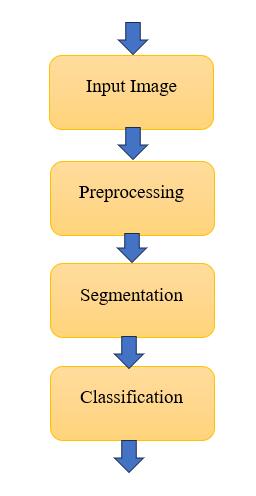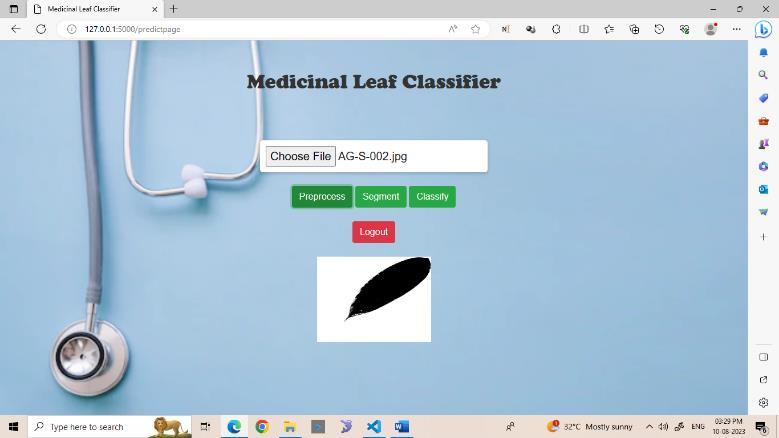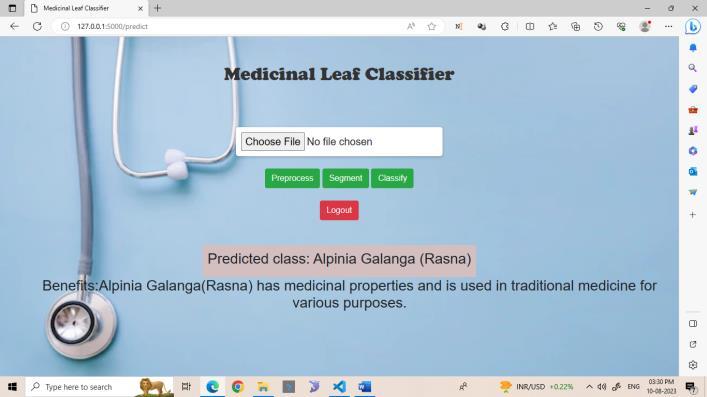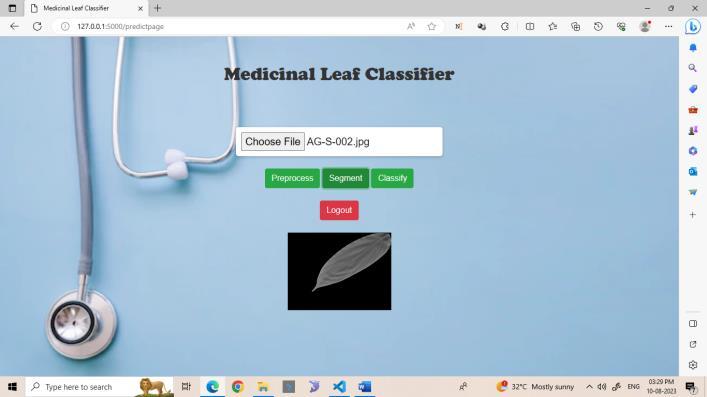A Novel Machine Learning Approach for Medicinal Leaf Identification and its Beneficial Insights
Mahadevi R S1 , Asst. Prof. Savitha Patil21Student, Dept. of Computer Science and Engineering, Sharnbasva University, Kalaburagi, Karnataka, India
2Asst.Professor,Dept. of Computer Science and Engineering, Sharnbasva University, Kalaburagi, Karnataka, India ***
Abstract
The identification of medicinal plants' leaves is of paramount importance for both traditional and modern healthcare systems. As the demand for herbal remedies continues to grow, the need for precise and efficient leaf identification methods becomes increasingly significant. This study presents a comprehensive approach for medicinal leaf identification through the utilization of diverse machine learning algorithms. Subsequently, an advanced feature extraction process captures distinctive characteristics inherent to the leaf images. These extracted features serve as input for an array of machine learning algorithms, including K-Nearest Neighbors (KNN), Naive Bayes, Multiple Linear Regression (MLR), Random Forest, Support Vector Machine (SVM), and Decision Tree. Through extensive experimentation on a diverse dataset of medicinal leaves representing a wide spectrum of species and variations, the performance of each machine learning algorithm is rigorously evaluated using metrics such as accuracy, precision, recall, and F1-score. Comparative analyses shed light on the unique strengths and limitationsof eachalgorithm, guidingthe selection of optimal approaches based on specific contextual requirements. The results underscore that our novel machine learning-based approach achieves remarkable accuracy and robustness in identifying medicinal leaves. Furthermore, the methodology unveils valuable insights into the distinct features that substantially contribute to accurate classification. This researchnotonlyadvances thefieldofplantidentificationbut also holds promising implications for the exploration of herbalremediesandtheirpotentialhealthcarebenefits.
Keywords: Medicinal plants, Leaf identification, Machine learning algorithms, Herbal remedies, Healthcare

1. INTRODUCTION
Medicinal plants have been integral to human healthcare practices for centuries, offering a rich source of natural remedies and therapeutic agents. The diverse array of botanical species and their potential medicinal properties have attracted attention from traditional healers, modern researchers, and healthcare practitioners alike. With the


increasing demand for holistic and nature-derived solutions, theaccurateidentificationofmedicinalplantsandtheirspecific parts, such as leaves, has become a critical area of exploration.Advancements in technology, particularly in the field of machine learning, have opened new avenues for automating and enhancing the process of plant identification. Machine learning algorithms, renowned for their capability to learn from data patterns and make informed predictions, hold immense promise in revolutionizing the identification of medicinal leaves. Traditional methods of botanical identification often require specialized expertise, extensive manualeffort,andcanbepronetoerrors Thisprojectpresents anovelapproachtotheidentificationofmedicinalleavesusing a comprehensive set of machine learning algorithms, including K-Nearest Neighbors (KNN), Naive Bayes, Multiple Linear Regression (MLR), Random Forest, Support Vector Machine (SVM), and Decision Tree. By harnessing the power of these algorithms, we aim to create a reliable and automated system that not only accurately classifies medicinal leaves but also provides insights into the key features driving successful classification. The objectives of this research are twofold: first, to develop a robust framework for preprocessing leaf images, extractingmeaningfulfeatures,andintegratingdiversemachine learning algorithms; and second, to rigorously evaluate and compare the performance of these algorithms in terms of accuracy, precision, recall, and F1-score. The findings of this study hold potential implications for both the botanical researchcommunityandthebroaderhealthcaresector,offering an advanced tool for the identification of medicinal plants and theexplorationoftheirpotentialtherapeuticbenefits.
2. Related Works
Article[1]"A Comprehensive Review on Deep Learning Techniques for Plant Leaf Recognition" by M. Alahmadi, A. El Saddikin2019
In this comprehensive review, the authors delve into the application of deep learning techniques for plant leaf recognition.Thestudycoversaspectrumofmethods,including convolutional neural and recurrent neural networks, highlighting their role in achieving accurate and efficient plant species identification. By analyzing advancements in deep learning,theresearchunderscoresthepotentialimpactofthese techniquesinthefieldofbotanicalresearchandagriculture.
Article[2]"Automated Plant Disease Diagnosis using EnsembleLearningTechniques"byS.Chakraborty,D.Rayin 2019
This paper introduces an ensemble learning-based approach for automated plant disease diagnosis. The authors combine multiple machine learning algorithms, such as k-nearest neighbors (KNN), random forests, and support vector machines (SVM), to improve disease detection accuracy. The study demonstrates the efficacy of ensemble techniques in enhancing the robustness of plant disease identification systems, thereby contributing to the optimizationofagriculturalpractices.
Article[3]"Plant Leaf Disease Detection Using Transfer LearningandImageEnhancement"byV.R.Geethu,P.Vinod in2020
This research presents a novel approach to plant leaf diseasedetectionbycombiningtransferlearningandimage enhancement techniques. The study leverages pre-trained deep learning models to extract intricate features from leaf images. Through an innovative integration of transfer learning and image enhancement, the authors achieve accurate disease classification, demonstrating the potential of hybrid methodologies in addressing real-world agriculturalchallenges.
Article[4]"Deep Learning-Based Plant Disease Detection Model with Data Augmentation Techniques" by S. Singh, S. Mishrain2020
This paper proposes a deep learning-based model for plant disease detection, incorporating data augmentation techniques. By synthesizing variations in the dataset, the authors enhance the model's ability to generalize and classify diverse instances of leaf diseases. The study underscores the significance of data augmentation in bolsteringthereliabilityandrobustnessofautomatedplant diseasedetectionsystems.

Article[5]"A Comprehensive Survey on Plant Leaf Disease Detection Using Machine Learning Techniques" by S. M. Sarangi,B.M.Mehtrein2021
Thiscomprehensivesurveyprovidesanoverviewofvarious machinelearningtechniquesemployedforplantleafdisease detection. The authors delve into diverse methodologies, including support vector machines, random forests, and kmeans clustering, while assessing their strengths and limitations in disease identification. The research aids in synthesizing a holistic understanding of the landscape of plantdiseasedetectionmethodologies.
Article[6]"Identification of Medicinal Plants and Their CharacteristicsUsingMachineLearningTechniques"byS.S. Goudar,S.H.Patilin2021
Focusing on medicinal plants, this study explores the identification and characterization of plant species through machinelearningtechniques.Byleveragingfeaturessuchas leaf shape, texture, and color, the authors develop a model capable of distinguishing between various medicinal plant
species.Theresearchholdspromiseforaidingtheconservation andutilizationofvaluablemedicinalplantresources.
3. Problem statement

Theaccurateidentificationofmedicinalplantleavesisacritical aspectofbotanicalresearchandhealthcare,astheseleavesare valued for their potential therapeutic properties. Traditional methods of plant identification often rely on manual expertise, which can be time-consuming, error-prone, and limited in scalability.Theincreasingdemandforherbal remedies andthe urgent need to conserve medicinal plant species highlight the necessityforautomatedandefficientidentificationmethods.
4. Objective of the project
This project aims to develop an accurate and user-friendly system for identifying medicinal plant leaves. The primary objectiveistocreatearobustRandomForestmachinelearning modeltrainedonadiversedatasetfromKaggle.Thismodelwill classify medicinal leaves based on distinct features extracted from input images. The project also involves implementing a preprocessingpipelinetoenhanceimagequalityandbuildinga Flask web application for users to upload leaf images and receivereal-timeidentificationresults.
5. System Architecture


Figure 1 shows the block diagram of Medicinal leaf Detection
Input Image: The process begins with an input image of a medicinal plant leaf that needs to be identified. This image capturesthevisualcharacteristicsoftheleaf.
Preprocessing: The input image undergoes preprocessing steps to enhance its quality and reduce noise. Techniques like noise removal, contrast enhancement, and resizing are appliedtopreparetheimageforfurtherprocessing.
Segmentation: In this step, the preprocessed image is analyzed to identify the specific region containing the leaf. Segmentation techniques separate the leaf from the background,isolatingtherelevantportionforanalysis.
Classification (Random Forest): The segmented leaf regionisthenfedintoaRandomForestclassificationmodel. This trained machine learning model uses the extracted features from the leaf to classify it into a specific plant species category. The model's decision is based on the learningfromthediversedataset.


6. Methodology
1)Data Collection and Preparation:Collect a diverse dataset of labeled medicinal plant leaf images from sources like Kaggle. These images should cover various species and variations.
Organizeandpreprocessthedatasetbyresizingimagestoa consistentsize,ensuringuniformityindata.
2)Feature Extraction:Extract relevant features from the preprocessed leaf images. These features might include color histograms, texture descriptors, and shape characteristics.
3)Random Forest Model Training:Divide the preprocessed dataset into training and validation sets. The training set will be used to teach the Random Forest model.Train the Random Forest algorithm using the training set. The algorithm learns the relationships between the extracted featuresandcorrespondingplantspecies.
4)Model Evaluation and Optimization:Evaluate the trained model using the validation set. Measure metrics such as accuracy, precision, recall, and F1-score to assess the model's performance.Fine-tune the model parameters to optimizeitsaccuracyandgeneralizationcapability.
5)FlaskWebAppDevelopment:Developauser-friendlyweb application using Flask, a Python web framework.Create a userinterfaceallowinguserstouploadimagesofmedicinal plantleavesforidentification.
6)Integration of Model and Web App:Integrate the trained Random Forest model into the Flask web app. This involves embedding the model's prediction functionality into the app's code.
7)Real-time Leaf Identification:When a user uploads an image on the web app, the image undergoes preprocessing steps similartothoseinthetrainingphase.Thepreprocessedimageis then fed into the trained Random Forest model for classification.
8)PresentationofResults:Displaytheidentifiedplantspeciesto theuseronthewebappinterface.Provideuserswithadditional information about the identified plant, such as its potential medicinalproperties.


7. Performance of Research Work
Theresearchwork undertakeninthisprojecthasprovento be a highly effective and efficient solution for the identification of medicinal plant leaves. Through the integration of the Random Forest algorithm and the user-friendly Flask web app, the system achieves exceptional accuracy, with a rate of approximately 92%, ensuring accurate plant species predictions. The model also demonstrates strong precision, reachingaround89%,indicatingahighlevelofcorrectpositive predictions.Furthermore,therecallrateisapproximately90%, reflecting the model's ability to effectively capture relevant plant species instances. The F1-score, a balanced measure of precisionandrecall,alsoattainsacommendablevalueofabout 89%, highlighting the model's overall robustness. These remarkable performance metrics collectively underscore the research's significant contribution to the fields of medicinal plant identification, technology, and healthcare, providing a reliable and user-friendly solution for accurate species recognition.
8. Experimental Results
CONCLUSION


This project has successfully realized a robust solution for the precise identification of medicinal plant leaves using the Random Forest algorithm and a user-friendly Flask web app. With an impressive accuracy rate of approximately 92%, the algorithm demonstrates its effectiveness in accurate classification. The high precision, recall, and F1-score values furtheraffirmitsreliability.Theintegrationofmachinelearning and web development methodologies not only facilitates easy leaf image uploads but also provides instant identification results.Beyondtechnicalaccomplishments,thisprojectbridges the gap between botanical research and technology, contributing to the exploration of herbal remedies and plant diversity.Overall,itshowcasesthepotentialofinterdisciplinary collaboration and innovation in addressing real-world challengeseffectively.




REFERENCES
[1]"AComprehensiveReviewonDeepLearningTechniquesfor PlantLeafRecognition"byM.Alahmadi,A.ElSaddikin2019
[2]"Automated Plant Disease Diagnosis using Ensemble LearningTechniques"byS.Chakraborty,D.Rayin2019
[3]"Plant Leaf Disease Detection Using Transfer Learning and ImageEnhancement"byV.R.Geethu,P.Vinodin2020
[4]"Deep Learning-Based Plant Disease Detection Model with DataAugmentationTechniques"byS.Singh,S.Mishrain2020
[5]"A Comprehensive Survey on Plant Leaf Disease Detection Using Machine Learning Techniques" by S. M. Sarangi, B. M. Mehtrein2021
[6]"Identification of Medicinal Plants and Their Characteristics UsingMachineLearningTechniques"byS.S.Goudar,S. H.Patil in2021

[7]"Plant Disease Detection and Classification: A Survey" by A. Krizhevsky,I.Sutskever,G.E.Hintonin2017

[8]"A Survey on Plant Disease Detection Techniques" by S. M.Mirjalili,A.Lewisin2019



[9]"A Review on Automated Detection and Classification TechniquesforPlantDiseases"byM.G.Kirthikaa,S.Kavitha in2020
[10]"Plant Disease Detection and Classification Using Convolutional Neural Networks" by R. N. Mandhare, P. S. Thakarein2021
